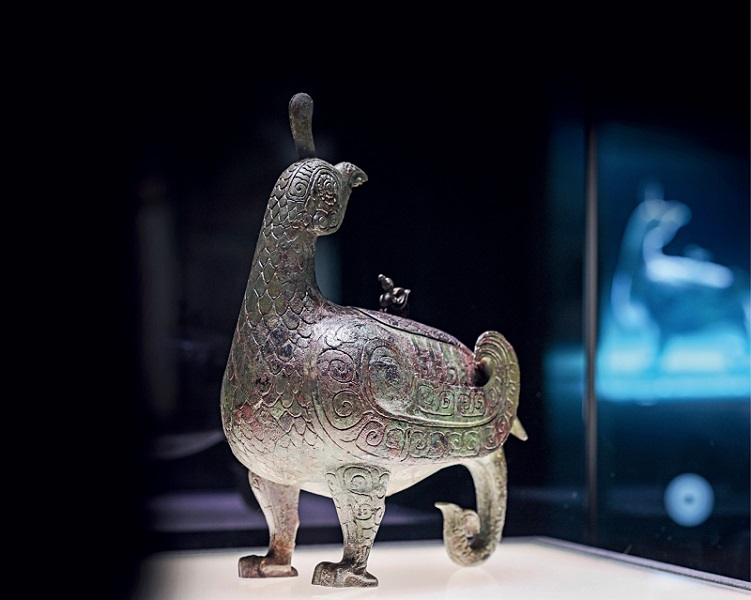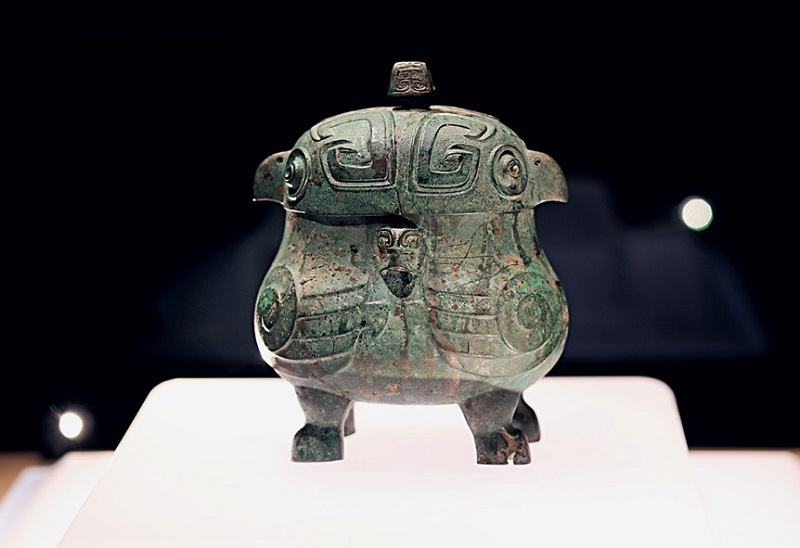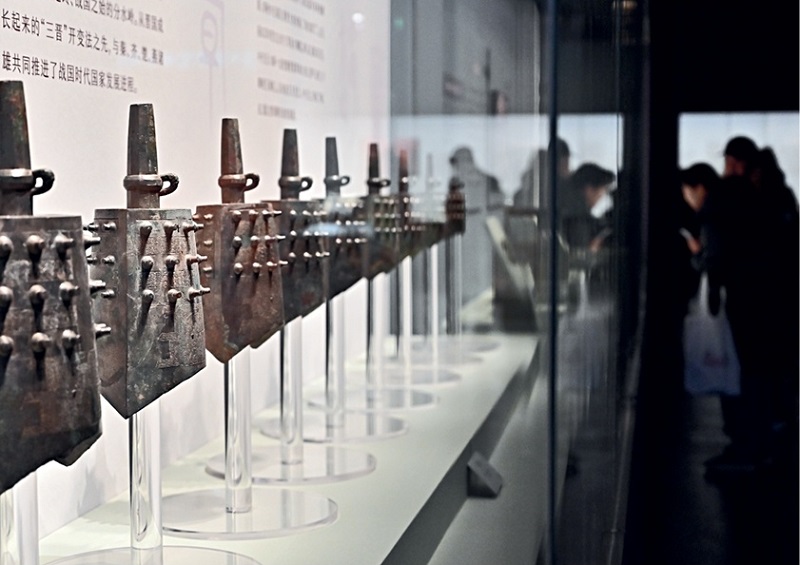
The Marquis of Jin’s bird-shaped zun is one of the most precious artifacts of the Shanxi Museum.
The Shanxi Museum, located in Shanxi Province in central China, a region which boasts a long history and rich cultural heritage, is a treasure house of over 500,000 cultural relics. Several of them have been recognized as national treasures, including the owl-shaped you (a wine vessel) from the Shang Dynasty (C.1600-1100 B.C.), the Houma Covenants (497-489 B.C.) , Marquis of Jin’s bird-shaped zun (a wine vessel) from mid-Western Zhou Dynasty (C1100-771 B.C.), a coffin from the Sui Dynasty (581-618), and a variety of brick carvings portraying opera scenes from the Jin (1115-1234) and Yuan (1271-1368) dynasties.
Bird-Shaped Bronze Vessels
The Marquis of Jin’s bird-shaped zun is the biggest treasure of the museum. During the 1990s, archaeologists discovered the burial site of the Marquises of Jin (the rulers of the Jin State) in Shanxi. Among the excavated artifacts was a collection of bronze vessels inscribed with the title of the marquis, with the bird-shaped vessel being one of the most representative pieces.
This object resembles a phenix looking back over its shoulder. On its back, a little bird rests, vividly portraying a mother-child bond. However when viewed from its tail, the artifact takes on the appearance of an elephant, demonstrating exceptional craftsmanship and creativity. The elephant’s raised trunk serves as the third supporting point of the vessel, ensuring its stability, while the phenix’s upturned wings ingeniously form the elephant’s ears.
Even more astonishing is the lid on the large bird’s back, and the small bird serves as the handle. Inside the lid and at the base of the vessel, an inscription of nine characters indicates that this vessel was an important ritual object used by the Marquis of Jin to honor his ancestors. Its creative design and distinctive role have made it the most treasured relic in the Shanxi Museum.
Another national treasure is the owl-shaped you, an adorable object dating back to the Shang Dynasty. Because the Shang people loved drinking wine, they created many exquisite wine vessels. This artwork has two cute owls standing back-to-back with their heads raised high. The lid is decorated with thunder patterns, while the body features curled feather motifs. Ingeniously crafted, this vessel is not only a wine container but a stunning work of art as well.

The owl-shaped you at the Shanxi Museum.
The Houma Covenants
Amid the chaos during the Spring and Autumn Period (770-476 B.C.), to strengthen alliance against common enemies, some clans or states often held meetings where they pledged allegiance to each other and created covenants documenting these meetings and the oaths taken.
In 1965, more than 5,000 fragments of inscribed stone and jade tablets were unearthed in Houma, the site of the last capital of the State of Jin during the Spring and Autumn Period, in present-day southern Shanxi. Among those shards, 656 pieces are decipherable.
Studies show that the inscriptions, mostly written in ancient Jin characters in red ink, record how a Zhao family-led alliance consisting of families with the surnames of Zhao, Han, Wei, and Zhi vanquished the Fan and Zhonghang families between 497 B.C. and 498 B.C. Since these ancient archives were found in the historical site of Houma, they are called the Houma Covenants.
The covenants include oaths, liabilities of oath takers as well as divination and curses. Serving as political archives, the Houma Covenants are of vital importance in the study of Jin history, ancient alliance practices, and ancient Chinese characters.
An Ancient Diplomat
The white marble coffin of an official called Yu Hong was unearthed from his tomb in 1999 in Taiyuan. It was decorated with intricate relief carvings and colored paintings exhibiting Central Asian and Persian styles.
Over 50 individual paintings can be seen on the coffin, depicting scenes of a banquet, music playing, dancing, hunting, domestic life, and traveling. The figures in the paintings have the features of Mediterranean Caucasians.
According to the epitaph, Yu Hong came from Yuguo, a state in the Western Regions (a name that refers to Central Asia and present-day Xinjiang). At the age of 19, he was sent to the state of Northern Qi as an envoy and worked there as an official. Throughout his career, he held prominent positions in the Northern Qi, Northern Zhou, and Sui states.
Yu Hong came from a multicultural background and his coffin serves as a crucial historical evidence of inter-civilizational exchanges during a bygone era. It also highlights the fact that as early as 1,400 years ago, Jinyang (present-day Taiyuan) was a center of economic, cultural, and artistic exchanges between China, Central Asia, and the Middle East, playing a vital role in international interactions.
Techs Bring Relics to Life
Shanxi was a major birthplace of Chinese opera and numerous Jin Dynasty (1115-1234) opera-themed brick carvings have been unearthed in various parts of the province. In the tomb of Dong Ming (a man from a local wealthy family who died in 1196) in Houma, archaeologists discovered a brick carving depicting a lavish stage and a group of opera performers. The theater showed the typical architectural style seen during the Song and Jin dynasties. The facial expressions, postures, and costumes of the five painted figurines show that Chinese opera at that time had developed different roles and was evolving to a new height of popularity. The theater scenes in this tomb indicate that opera culture was flourishing during that period.
During the 2025 Spring Festival Opera Gala, broadcast by China Central Television, animated Jin Dynasty opera performers and the Marquis of Jin’s bird-shaped zun, created through digital technologies, joined the audience in front of the well-known ancient theater stage at Jinci Temple in Shanxi. This creative arrangement garnered glowing reviews from netizens.
To deepen people’s appreciation of cultural heritage, the museum has launched a virtual exhibition in addition to onsite activities. Twelve galleries are presented online with the help of 3D models, images, text, videos, narrations, and other cutting-edge virtual reality technologies, providing virtual museum tour.

Visitors view a set of chimes from the Spring and Autumn Period. In December 2024, the Shanxi Museum launched an exhibition, "Changes – Jin and Qin during the Spring and Autumn Period,” showcasing the friendship and rivalry between the Jin and Qin states in that period.
Relic-Inspired Events
The Shanxi Museum also routinely hosts fun cultural activities.
On May 18, International Museum Day, last year, the museum hosted a range of onsite activities to celebrate this day. In its theater-themed gallery, volunteers performed a shadow puppet show inspired by classic stories. In another activity, visitors colored cards which featured traditional architectural patterns, including caisson ceilings, eave tiles, and window frames. The activity was designed to inspire people’s interest in China’s traditional architectural culture.
In January last year around the Chinese New Year, the museum invited 20 foreign students from Taiyuan University of Technology to explore its exhibits and experience traditional Chinese customs such as pitch-pot (an ancient game of throwing arrows from a distance into a pot), and printing woodblock New Year paintings. Through participating in these hands-on activities, these young people learned about China’s rich history and vibrant culture.
During the summer of 2024, the museum launched a “Cool Summer: Longer Opening Hours” program. In addition to extending opening hours, a creative cultural market was set up on the Eastern Plaza, featuring over 100 creative cultural products, along with interactive games. In the “Jin Soul” zone, visitors, equipped with AR glasses and maps, could embark on treasure hunts for AR educational bags and commemorative stamps. All of these activities gave visitors an unforgettable experience.